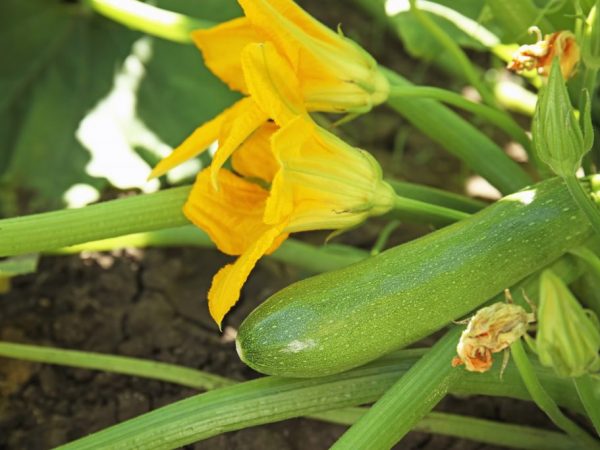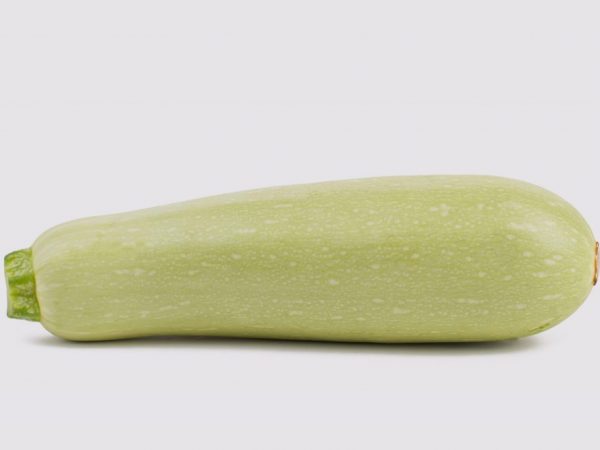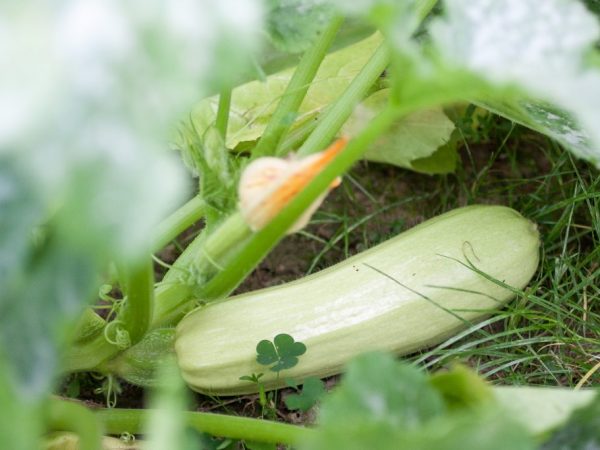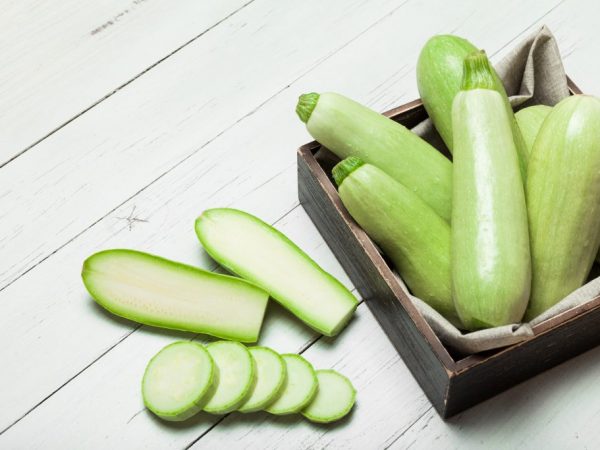Zucchini Cavili
The unpretentious Kavili zucchini is popular with gardeners. It is resistant to disease. Subject to the rules of care, the farmer will receive a large harvest. The vegetable is suitable for growing outdoors and indoors.

Zucchini Cavili
Description of the variety
The Kavili F1 squash is the result of a Dutch selection. It belongs to bush plants. The culture has the following description:
- internodes are short;
- leaves are large, spreading, dark green, spotted, with prickly pubescence;
- the root system is superficial, occupies a large area compared to the aboveground part of the plant;
- flowers are bisexual, large, orange.
Flowering occurs during the day. Under stress, bud setting is possible without pollination.
Description of the fruit:
- the shape is cylindrical, correct;
- weight 0.3-0.5 kg;
- length up to 22 cm;
- light green color;
- the pulp is white, tender, juicy, pleasant to the taste.
Seed preparation for sowing
Seed material is used only purchased. Harvested from last year will not work. The seeds do not need to be specially prepared. To speed up the germination, it is worth performing certain manipulations:
- soak them in warm water for several hours;
- wrap in a damp cloth for a day.
The seeds should swell. It is important to ensure that they do not germinate. It is not worth etching them, because they have already been treated with special substances.
Cultivation methods
Cavili gives a good harvest on loose loamy soils with neutral acidity. Other types of soil will have to be improved. Sand is added to clay soil, peat is added to sandy soil, which retains moisture.

Large and juicy fruits
In the open field
A well-lit and warm area is suitable for the variety. It is required to prepare it in the fall. For this, the bed is cleaned. The earth is dug to a depth of 35 cm, the following fertilizers are applied to 1 m2:
- 6-8 kg of rotted manure or compost;
- 50-60 g of superphosphate and potassium salt.
For depleted soils, the amount of top dressing made should be increased.
In the spring, a week before planting, 50-60 g of ammonium nitrate per 1 m² are introduced into the soil. They dig up an earth 25 cm thick. The ground is ready for landing if the lump crumbles when thrown.
When the temperature drops, the plants should be covered. To do this, use a film or mulch the bushes with manure. Otherwise, they will be harmed.
In the greenhouse
In regions with a cold climate, it is better to plant zucchini in protected ground. Growing principles are the same as in the open area. The advantages of this kind of cultivation:
- reduction of the growing season;
- obtaining a high yield in a short time;
- improving the palatability of fruits;
- plants do not freeze, because the temperature in the greenhouse is constant.
The soil is dug up in the fall to a depth of 8 cm, applying fertilizers. If the gardener did not have time to feed, then this can be done in the spring. Before planting, the soil in the hole is mixed with nitroammophos.One plant accounts for 30-40 g of the substance.
Optimal greenhouse conditions for planting:
- soil temperature - 20-25 ° С;
- air during the day - 23 ° С, at night - above 14 ° С.
In warm beds
If it is not possible to build a greenhouse, and the climate in the region is cold, it is worth making a warm garden bed. The advantages of this method:
- getting an early and high harvest;
- no feeding is required in the first year;
- ease of care;
- no threat of freezing.
The work is laborious, it starts in the fall First, a wooden box with a height of 0.5 m is built. The bottom is made of a mesh with small cells. Then it is installed in a well-lit place and the following layers are laid:
- Drainage - made from substances that decompose for a long time. Branches, rotten boards, cardboard, etc. will do.
- The ground is 3 cm.
- Plant and food waste - 10-15 cm.
- Soil - 10 cm.
- Manure - 10 cm. Instead of it, plant residues are sometimes taken.
- Ground - 20 cm.
Planting methods

Zucchini are planted on prepared beds
Zucchini are planted in 2 methods: using seeds and seedlings. It is required to observe the crop rotation. In front of the zucchini in the garden, the following crops should grow:
- legumes;
- cabbage;
- potatoes;
- tomatoes;
- winter wheat.
Do not plant Cavili F1 after cucumbers, pumpkins and squash. Plants are capable of suffering from the same diseases.
Planting seeds
In warm regions, zucchini begins to be planted at the end of May. By this time, the air temperature should be at around 18 ° C, and the temperature of the soil at a depth of 10 cm - 12 ° C. The weather can extend the process until early June.
In each hole 5-6 cm deep, 2-4 seeds are placed. Planting scheme: 70 × 140 cm. After germination, the strongest sprout is left, and the rest are cut off.
Growing from seedlings
Seeds are planted in late April - early May. To do this, take containers with a diameter of 10 cm and put 2-3 seeds in the soil. So during transplantation, the root system will not be damaged. Peat pots are also suitable for growing seedlings.
Seeds are placed 3-4 cm deep, with a sharp tip down. The room temperature should be 25-28 ° C. The first shoots will appear in about 4 days. Weak shoots are removed, leaving one of the strongest. Then the pots are placed in a lighted place, gradually reducing the temperature to 18 ° C. A week before planting, the seedlings are hardened. For this, the temperature indicators should be as follows:
- 16-17 ° С in the daytime;
- 13 ° C at night.
Plants are fed with complex fertilizer 2 times:
- a week after germination;
- a week after the previous feeding.
Watering is carried out as the top layer of the earth dries up. Seedlings are planted in the ground at 20-25 days of age. Plants should be in the ground up to cotyledonous leaves. In the first week they are covered.
Zucchini care
In order for the culture to please with a good harvest, it is worth providing it with optimal conditions. Plants don't like shading. Even their own leaves can interfere with the access of light, so it is best to remove large and old leaves.

Great yield with proper care
Watering
The water temperature for moistening the soil must exceed 20 ° C. It is poured at the root in the evening. The optimal amount of liquid should be as follows:
- before fruiting - once a week, 9-10 liters per 1 m²;
- during fruiting - 2-3 times a week, 15 liters of water per 1 m².
Zucchini tolerate drought, but in hot weather the humidity level increases. Otherwise, the leaves will droop, and the yield will decrease by 3 times.
Mulching and loosening
The first time the soil is loosened with the emergence of seedlings or 2-3 days after planting seedlings. Such manipulations are performed on the second day after each watering or rain. In the row spacing, the soil is loosened to a depth of 14 cm, under the bush - by 5 cm.
Mulching is done to keep the soil moist. To do this, take sawdust, crushed hay or peat chips.
Top dressing
In certain phases of growth, fertilizers are applied at a dosage of 1 liter per bush:
- before flowering - 10 liters of water, 1 liter of liquid manure, 20 g of nitrophoska;
- during flowering and fruit formation - 10 liters of water, 40 g of wood ash, 20 g of complex mineral fertilizer;
- during the ripening of zucchini - 10 liters of water, 30 g of nitrophoska.
Top dressing is not done if nutrients were added in the required amount before planting. This is especially true for the greenhouse growing method. Otherwise, leaves and shoots will actively grow, interfering with the formation of ovaries.
Harvesting and storage
The variety is characterized by long-term fruiting. Zucchini is harvested from early July to mid-August. From the appearance of full shoots to the formation of zucchini, it takes from 40-45 days. Sometimes the fruits continue to set until the onset of cold weather. Yield indicators are high - up to 9 kg per 1 m².
Overripe zucchini Cavili F1 do not lose their taste, but it is better to collect them on time. Otherwise, the bush will be overloaded, the yield will decrease. Young fruits are unsuitable for storage because they have a thin skin. Mature ones are kept in the cellar for about 2 months. To do this, they are laid on a wooden surface in 1 layer. The best place to store zucchini in an apartment is an unheated balcony. Each fruit is wrapped in paper and placed in a dark place. The zucchini will stay in the refrigerator for about a month.
Diseases and pests of zucchini
Cavili F1 is resistant to powdery mildew. Common diseases and measures to combat them are as follows:
- Peronosporosis - white spots appear on the leaves, which grow and turn brown. The lower part is covered with a gray-olive bloom. Over time, the leaves crumble. A 0.2% solution of 80% Cineb is used against the disease. Also use Zaslon or Oksikhom. The dosage of drugs is determined according to the attached instructions.
- Anthracnose - affects leaves and fruits. On the first, yellow-brown spots appear, on the second - pale pink. In the fight against the disease, a 1% solution of Bordeaux liquid or a 0.4% solution of copper sulfate is used.
Also, the Kavili zucchini is affected by pests:
- Spider mite - small white dots and a cobweb appear on the leaves. With a massive invasion, leaf plates turn white. The drugs Iskra and Karbofos are used against the pest. The dose is determined according to the instructions.
- Melon aphid - sucks the juices from the leaves, which leads to their curling. The ovaries fall off. Over time, the bush dries up. To combat the pest, the drug "Karbofos" is suitable.
To prevent the development of diseases and the invasion of insects, it is worth taking the following preventive measures:
- observe crop rotation;
- in the fall, remove the remnants of vegetation from the site;
- reject seedlings;
- buy disinfected seeds;
- do not overmoisten the soil;
- destroy weeds.
It will be possible to scare off pests with the help of a folk remedy. For its preparation, take 1 cup of chopped garlic, 1 tbsp. l. crushed red pepper, 1 piece of laundry soap, which is grated. Marigolds are also planted near the garden bed or between the plants.
Conclusion
Zucchini lovers speak positively about the Cavili F1 variety. It allows you to get a high yield with minimal effort and time. The compactness of the bushes saves space, which is beneficial in small areas. It will be possible to purchase seeds at a low price. Zucchini are suitable for cooking and canning. They can be dried and frozen.

